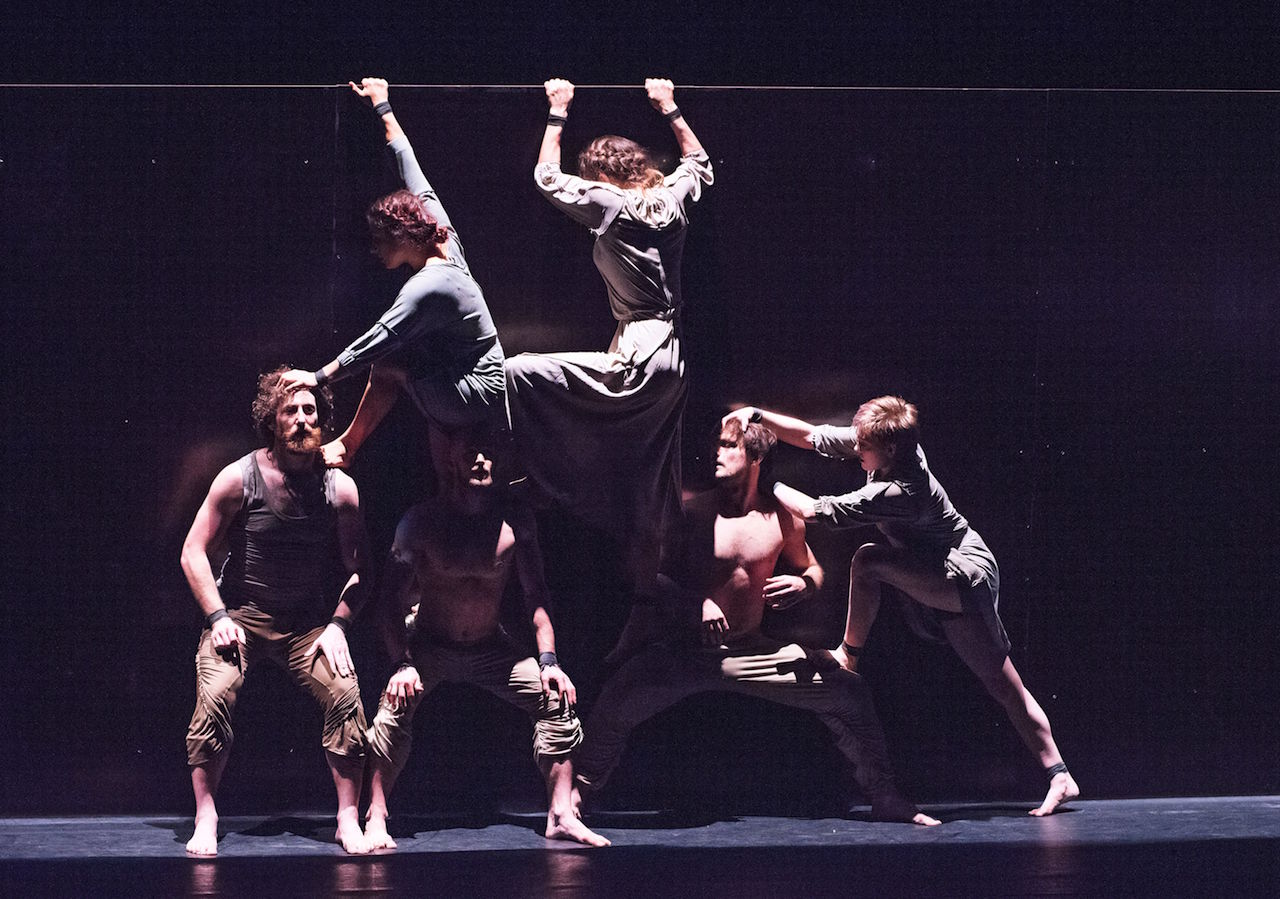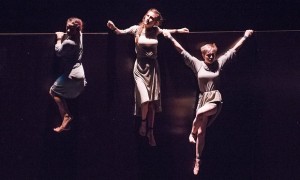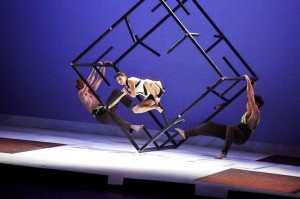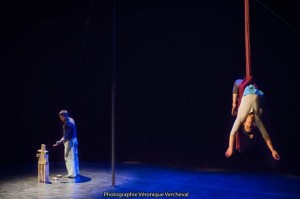Across the Barbican’s vast stage – right across, east to west – is a wall. It could be anywhere: Berlin pre-1989; the West Bank, anytime over the past 30 years. It could be now: Bulgaria, Macedonia, Hungary; the entrance to the Channel Tunnel at Calais. It’s perhaps 3 or 4 metres high, a mottled rusty-grey metal. Six figures, dressed in muted blues and greys, are dotted around the space in front of the wall, lit by a tunnel of light that casts them as puppets on a marionette stage. Or rabbits caught in the headlights. Or, indeed, fleeing people illuminated by searchlights. Over the next hour, the six acrobats – three men and three women – act out a painstaking choreography. They are caught in the wind, or perhaps the waves, tumbling and rolling across the stage in pairs, hanging on to each other in desperation. They are grouped backs-against-the-wall, staring out at us pleadingly. They form towers, or create tortuous hand-to-hand balancing poses as they scramble up and over each other, but without any of the usual ‘aids’ into those difficult positions: often, there is no prep, no jumps or braces, they just have to – get there, somehow. Even more unnerving, they often don’t make eye contact with each other, giving a terrifyingly tentative look to many of the moves.
It’s a very clever game to play: these are some of the top circus performers in the world, and often their director (Circa founder Yaron Lifschitz) has created scenes in which their safety nets are taken away. There are wobbles, and shakes, and trembles – but these aren’t faked, they come from the arduous situations that have been set up. This is circus, not theatre: everything you see is real.
Circa’s The Return is not exactly a ‘version of’ but a kind of poetic re-interpretation of Monteverdi’s opera Il Ritorno de L’Ulysses de Patria, bringing together the Circa acrobats and an ensemble of five musicians and singers. Monteverdi’s opera, and Circa’s show, are inspired by one of the oldest poems in Western literature – Homer’s Odyssey, in which Odysseus (or Ulysses as the Romans renamed him) finds himself far from home, and cast adrift on a flimsy raft, tossed on rough seas, and washed ashore on a small Greek island. Yes, it is a story that has great contemporary relevance.
In the post-show discussion at the Barbican, where the show had its UK premiere as part of the London International Mime Festival, Yaron states with complete honesty that the current refugee crisis wasn’t the starting point for the show. It is, he says, a reflection on the core themes of the Odyssey – desire and absence – exploring the story of the 10-year separation of Odysseus from his wife Penelope, the tests that were placed on both of them, the desperate desire for re-unification, and (in Odysseus’ case) the longing to return home. Yet as the piece was being made, the constant, depressing news of Europe’s refugee crisis intruded upon the work. Yaron talks of the day that he, like so many of us, was stopped in his tracks by the image of a small Syrian boy, Aylan Kurdi, lying drowned on a Greek beach. As the creation process continued, the terrible photographic images (and the images conjured by the galling words of the news reports) that we have all been inundated with over the past year or two informed the development of the piece, which Yaron says has changed considerably since its first outing in their hometown of Brisbane, Australia.
For example, almost all the usual circus props have been discarded along the way – there is only one section with equipment, a scene in which the three women are each, independently, in their own space, working – one with straps, one hand-balancing, and one in a kind of cage-like metal cube serving as a type of static trapeze. Mostly, the cast are just there onstage together, telling stories through their bodies, without the equipment. But it is always circus that is the form doing the telling: ’I have only two rules. No acting. and no dancing,’ says Yaron.
So the six acrobats are not actors playing characters – there is no one Odysseus or one Penelope on stage, everyone is contributing to an abstracted reflection, a poetic expression in movement, of those key themes of desire and absence. And they are not trying to act out the feelings of being off-kilter, displaced, dispossessed – they are demonstrating that through the physical actions they have been directed to take. What we witness is a poignant portrayal of what it feels like to have everything cut from underneath you; to be cast adrift; to be displaced. Unlike Homer’s poem, there is no happy ending; no reuniting – we are left with an image that suggests that the uprooting, the moving on, the being pushed forward, is continuing, over and over and over again…
Belgian-based Theatre d’un Jour’s Les Inouis (seen in the UK as a work-in-progress at the Edinburgh Fringe 2015, and probably returning in 2016) also reflects on the struggles of displaced people, but has a rather different starting point. Creator/director Patrick Masset was originally intending to make a biographical piece about his Belgian father, who had migrated to Canada many years earlier, having lived and worked in what was then the Belgian Congo in Africa. He had been intermittently filming his father talking about his life for about four years, and at one point his father started complaining about the ‘crazy migrants’ Canada was taking in. No amount of arguing on Patrick’s part could make his father see that he was a migrant who was now showing the same prejudice to new migrants that was perhaps shown to him when he arrived in Canada with no family and no friends. ‘It’s not the same’ his father argued stubbornly.
This set him thinking – and the nature of the piece changed, to become focused on the plight of refugees and migrants, past and present. ‘It is not the artist’s role to provide answers, but to ask questions’ says Patrick, when I speak to him towards the end of the Edinburgh run. At this point, the show had had a brief development time, pre-Edinburgh, working for a month with Belgian migrants on their stories. Patrick was now working on a plan to take a new, smaller version to small villages, performing in a truck, and engaging people in the question of how to view the migrant ‘problem’. This show is now touring, and is called Les Inouis 2, and it aims to show how the reality of the emigrants of yesterday echoes the prejudice experienced by the migrants of today. The word ‘inoui’, incidently, has no exact translation to English – the nearest is probably ‘the unheard’ or ‘the voiceless’.
Patrick believes passionately that circus – like physical theatre, puppetry, film, and music which are all also elements of his work – can be used as a tool to explore difficult questions. There are many ways to tell stories, so ‘why not speak with circus?’.
When I see the show, it is still very fresh and new, but brimming with startling images. It weaves the story of a nameless man washed up on a shore, imagined by the girl who finds his dying body, with a bigger story of migration and environmentalism. The famous bicycles of the Calais Jungle, a makeshift migrant city, are suggested by a unicyclist moving around the space at the start of the piece, as three washed-up bodies lie on the ‘beach’ next to two carved wooden dolphin.
The central puppet is a human-size figure that alternates cleverly with a real human playing the migrant on the shore. The simple but effective animation, with human interaction from behind the translucent material that forms the screen, is used to tell the story – from both a human and an animal perspective – of a journey across the ocean. The movement work is sound, with some strong acrobalance sections. There is a beautiful slack wire act on which a woman gives birth to a puppet baby – it fits very well into the piece, suggesting the shaky vulnerability of women migrants giving birth whilst in transit.
The piece also tells a story of a border crossing with a wagon filled with caged birds. The birds can’t cross, because they don’t have the right documents. Their carer opens the cages and they fly across the border – a beautiful and pertinent image of a world without borders.
Also presented at Edinburgh Fringe 2015 was Palestinian Circus Company’s B-Orders, which won a Total Theatre / Jacksons Lane Award for Circus. ‘Imagine a world without borders and a life without prejudice’ is its tagline. It is created and performed by Ashtar Muallem and Fadi Zmorrod, both totally engaging onstage.
The pair use dance, acrobatics, Chinese Pole and silks in the telling of their story of the desire to break free of the boundaries of nationality, gender, religion. Also object animation and manipulation: each has a pile of bricks that are used to build walls, and houses, and human figures; to throw and kick; and to use as stepping stones to walk over to each other. Their onstage relationship is beautiful, poignant. They are all things to each other: sibling, friend, alter-ego, lover.
Afterwards, I speak to Fadi Zmorrod about the making of the show. He and Ashtar (Ash) have known and worked with each other since they were 15, and part of a growing youth circus scene in their hometown of Birzeit, a Palestinian town north of Ramallah in the central West Bank. Training is not easy in Palestine, and he has luckily been able to exit the country to attend short courses in Belgian, French or Italian circus schools. There is also YouTube, and Fadi says that to a great extent he and Ash are ‘self-taught’. Things are often hard, but ‘we have a sense of humour,’ he says. B-orders was made in a five-month spell in 2015, with spells of work of two to three weeks, devising different sections and working with different circus trainers. Part of their process involved interviewing people, old and young, to ask about what bothered or restricted them; their experiences of provocation on the streets; and the things that block people’s freedom. The piece is political, but it isn’t agit-prop. There is no single message, and many of the issues of ‘freedom’ explored relate as much to gender within Palestinian/Arab culture as to the specificities of the West Bank. ’Palestine is a masculinist society’ says Fadi. ‘In the villages, a young woman will have to take orders from her little brother.’
What he wants do in the work is to ‘hold up a mirror so people can see themselves’. His is a long-term displaced nation with no signs of any resolution to the dilemma of being, essentially, a refugee in your own country.
What he hopes for – for himself, for his circus company and school, and for his country – is ‘Belonging. Togetherness. Having a space.’
Ultimately, all three circus shows reflected on here are about that: belonging, togetherness, having a space to call your own. In other words, coming home.
Circa’s The Return was presented at the Barbican Theatre as part of the London International Mime Festival 2016. The post-show discussion was chaired by Dorothy Max Prior on behalf of LIMF on 28 January 2016.
See Total Theatre’s review by Thomas Wilson, here. For more on Circa, and full details on The Return and all the other shows currently in repertoire, see http://circa.org.au/
T1J’s Les Inouis and the Palestine Circus Company’s B-orders were seen at Circus Hub at the Edinburgh Festival Fringe 2015. Some of the material in this feature was taken from a previously published post on work seen at the Circus Hub, August 2015, for the Total Theatre Awards.
Theatre d’un Jour (T1J) is a cross-discipline company that makes works in many genres, under the artistic direction of Patrick Masset. In 2015, the company celebrated its twentieth anniversary. Currently touring shows include L’Enfant Qui, and Les Inouis 2. For more on Theatre d’un Jour (T1J) see: http://www.t1j.be/
The Palestinian Circus School / Palestinian Circus Company is a non-profit, non-governmental organisation, established in 2006 and registered with the Palestinian Authority since February 2007. It teaches circus in Birzeit and in other cities like Jenin, Hebron, Ramallah and Al Fara refugee camp. http://www.palcircus.ps/
Urgent call: 23-year-old Mohammad Faisal Abu Sakha, who works with the Palestinian Circus School, was detained by the Israeli military, without charge or explanation, on 14 December 2015, as he was on his way from his parents’ home, in the occupied West Bank city of Jenin, to work at the Palestinian Circus School in Birzeit, near Ramallah. See Amnesty International’s campaign here: https://www.amnesty.org.uk/actions/free-palestinian-circus-performer-held-israel
This feature is published as part of an ongoing collaboration between Total Theatre Magazine and The Ragroof Players related to the company’s research process for their site-responsive and community-specific show Bridges y Puentes. See http://www.ragroofplayers.co.uk/bridges-y-puentes.html Research material related to the project will be gathered on www.bridgesypuentes.com




